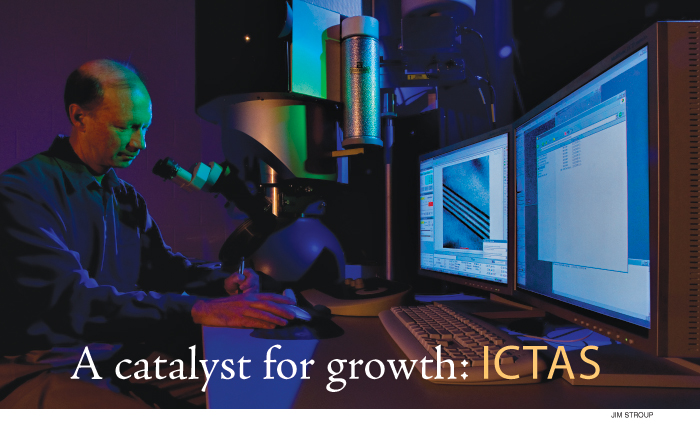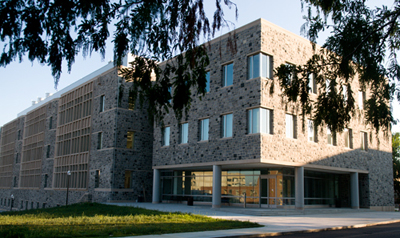 |
|
|
by ANN CRAIG
|
|
In 1998, Malcolm McPherson, then-associate dean for research and graduate studies in the College of Engineering, presented a plan to the College of Engineering Advisory Board for an interdisciplinary institute. This institute was envisioned to advance the sustainability and quality of life for humankind through collaborative research, to link colleges across the commonwealth, and to provide a strong basis for economic development. A group from Virginia Tech was authorized to study established models proven to produce strong economic growth around highly ranked universities that would encourage a seamless path from fundamental research through applied research and development to technology transfer. The impact of the models studied made a strong case for significant initial investment in a progressive and collaborative research structure: ICTAS. In 2000, new university President Charles W. Steger announced a goal of raising the university into the ranks of the nation's foremost universities by 2010. To help achieve this goal, the College of Engineering's Advisory Board created a task force that concluded that Virginia Tech must attract the world's best teachers, researchers, and graduate and undergraduate students, which led to the developmental efforts for the creation of the Virginia Tech Institute for Critical Technologies. Virginians voted on Nov. 5, 2002, to approve a bond referendum providing $900 million in funds for capital projects at public colleges and universities; included in the $95.3 million allocated for Virginia Tech projects was ICTAS Phase I. A volunteer task force of alumni raised $1.2 million in pledges to help construct and equip an institute building. Early funding success in research included an award from the National Institute for Occupational Safety and Health for construction safety and several awards related to vehicle technologies and unmanned vehicles research. Then, in 2006, the university named Roop Mahajan as the first permanent director for the institute. An internationally recognized researcher with expertise in thermal management, nanotechnology, and bio-micro-electro-mechanical systems, Mahajan arrived at Virginia Tech just as construction started on the first of three planned ICTAS buildings. The first building, located in the Corporate Research Center adjacent to the main university campus, opened in September 2007 and is home to the Nanoscale Characterization and Fabrication Laboratory (NCFL). The NCFL occupies approximately 16,000 square feet of laboratory space and houses dedicated instrumentation for bio- and nano-characterization, consolidating most of the characterization equipment available on the Virginia Tech campus. The facility is staffed with instrument and research specialists to train users, assist in the operation of the equipment, and collaborate on research projects. The Commonwealth of Virginia Research Initiative Fund provided more than half of the funding necessary to equip this state-of-the-art facility.
PROVIDING A NIMBLE RESEARCH CULTURE ICTAS aims to become among the top-rated institutes globally in transformative, sustainable technologies geared toward societal needs. To this end, core ICTAS research teams cover a wide array of societal concerns, and research results are applied in areas that impact local, national, and international policy. The core mission of ICTAS is to stimulate, catalyze, and promote interdisciplinary research at the intersection of engineering with physical sciences, life and social sciences, and medicine. ICTAS has identified and embarked on a number of strategic research initiatives in nanoscale science and engineering, molecular and cellular biology, sustainable development--including energy, water, and renewable materials--and cognition and communication. Some examples of these areas of research include studying and manipulating matter to enhance bone and tissue growth; developing tissue and venial replacements utilizing bacteria; creating new and renewable materials, such as keratin-based polymers extracted from chicken feathers or derived from biomass, or animal waste and plant materials; developing renewable energy sources with hydrogen and enzymatic fuel cells; harvesting of solar energy with enzymes; and conserving, preserving, and creating "new" water by improving existing water infrastructure and distribution systems and by designing and improving technologies for the effective treatment and desalination of waters. "The past two years have been productive in terms of establishing the infrastructure needed to facilitate and support strategic alliances and synergistic research," says Mahajan. "Our research concentration areas are well established and widely recognized, both internally and externally. We provide a collaborative atmosphere designed to stimulate and promote creativity, a place where intellectual capacity can be explored and challenged to reach areas previously explored in isolation. We are poised for research growth and discovery at a level never before achieved at Virginia Tech." ICTAS invests in research in many ways, including direct award of project funding; the purchase, installation, and maintenance of specialized equipment; investment in new faculty recruitment and hiring; graduate student support; matching research proposal funds; and making specialized research space available. Although all of these areas are important to the strategic growth of research, the institute's most outstanding investment is in bringing people together to collaborate in a way that fosters the combination of existing intellect and resources and then channels it toward breakthrough discovery. Entrepreneurial and dynamic in nature, ICTAS seeks to support and foster creativity, research, and technology transformation by nurturing a proactive, responsive, and, importantly, nimble research culture, ultimately positioning Virginia Tech as an agent of discovery and problem-solving in the technological and scientific global environment to enhance society and to preserve it for future generations. ANN CRAIG is director of communication and program development for the Virginia Tech Institute for Critical Technology and Applied Science. |
||||||||||||||||||||
|
|

